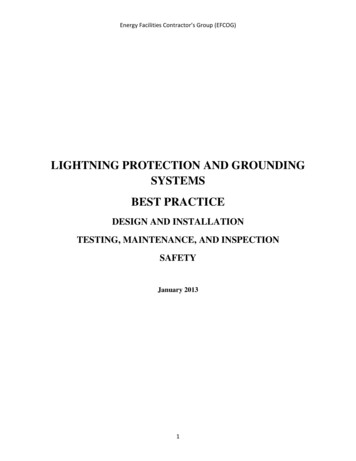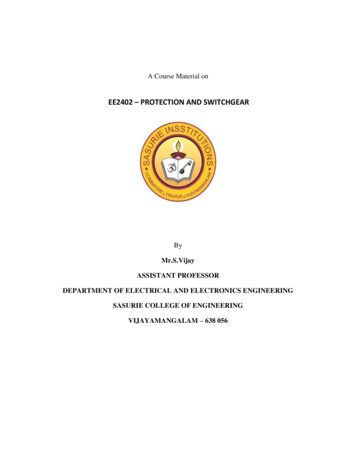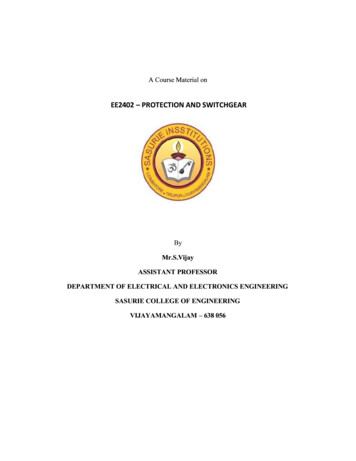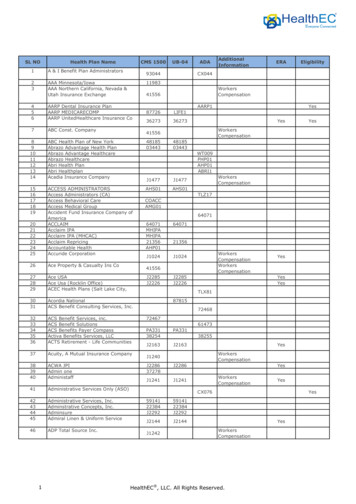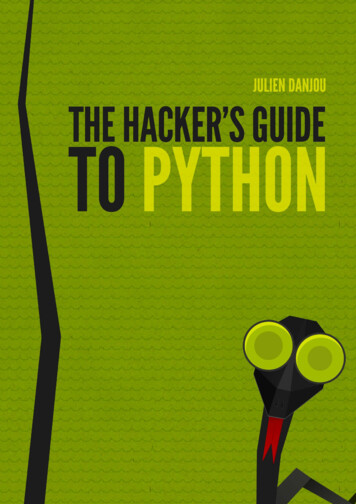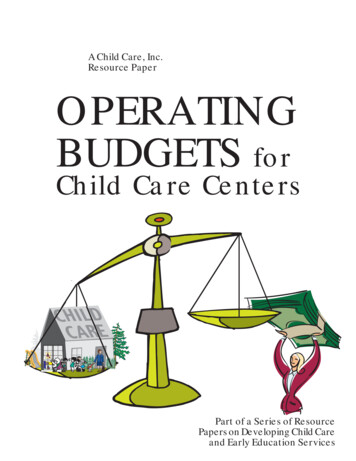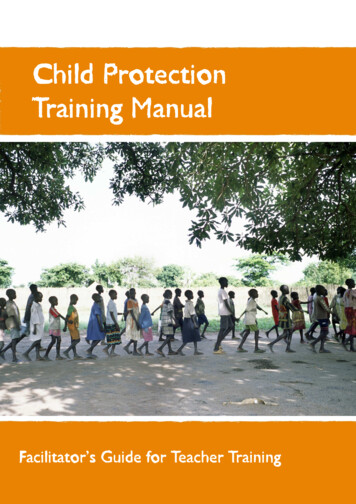
Transcription
Child ProtectionTraining ManualFacilitator’s Guide for Teacher Training1
We’re the world’s independent children’s rights organisation. We’re outragedthat millions of children are still denied proper healthcare, food, education andprotection and we’re determined to change this.Save the Children UK is a member of the International Save the Children Alliance, transforming children’s lives in more than 100 countries.Save the ChildrenHigh Malakal RoadJubaSouthern Sudansavethechildren.org.uk2
ContentsIntroduction4How to use the manual?Who is the manual for?44Facilitating the training5Preparing for the trainingTraining schedulesTips for good facilitationParticipatory methodologiesEnergisersSample evaluation form5678910Sessions for Teacher Training111-day Child Protection Refresher Training5-day Child Protection TrainingSession 1: What is child protection?Session 2: Who is a child?Session 3: Abuse, exploitation, violence and neglectSession 4: Identifying abuse and its impactSession 5: Responding to abuseSession 6: Preventing abuseSession 7: Southern Sudan Legal frameworks121819212438414652ReferencesAnnexes61623
IntroductionIncreasing access to and the quality of educationfor children in Southern Sudan continues to be themain focus of the education sector. Years of warhave had a tremendous impact on the availabilityand quality of educational facilities, but steps arecurrently being taken to address existing gaps.In 2008, for example, the Government of SouthernSudan enacted both the Education and the ChildActs. The Education Act provides a legal frameworkfor education policy in Southern Sudan and theChild Act extends, promotes and protects therights of children. In addition in 2008, the Ministryof Education, Science and Technology published aTeachers’ Code of Conduct which outlines rolesand responsibilities.It is of great importance that both teachers andstudents are aware of, understand, and can followthese laws and standards. Schools need to be protective places for children where they feel safe,nurtured and are encouraged to learn in a secureenvironment. This manual is to serve as part of anawareness raising effort to identify and addressissues of child protection in education in SouthernSudan.This resource was developed as part of the Savethe Children Alliance campaign to ensure dramaticchanges to children’s education in countries affected by conflict.Save the Children believes that the protection ofthe children is a collective, societal responsibilityexercised at family, community, civil society, stateand international levels. We recognize that by focusing and involving the right people this will contribute to addressing harms caused to children.Who is this Guide for?This manual was developed to help guide the facilitation of a child protection training for teachers,trainer of trainers for teachers (TOTs) and othereducation authorities. It was developed togetherwith a Teachers Handbook on Child Protection.This manual can also be used for the training ofmembers of Parent Teacher Associations (PTAs)and community-based child protection groups.The material was developed for use by facilitatorswho do not necessarily have much background inchild protection but who have been involved withdelivering trainings.How to use this Guide?The manual is divided overall into two sections:1: Facilitating the training2: Sessions for training teachersThe first section on Facilitating training includestips for preparation and facilitating the training.The second part includes suggestions for sessions.This guide to child protection consists of a Facilitator‘s Guide and a Teacher‘s Handbook. Thesewere designed for use together. Participants ofthe training should receive a Teacher’s Handbookwhilst the facilitator should use this Facilitator’sGuide to train them.Each section includes:Key learning pointsSession ContentsActivities / Group work4
Facilitating the trainingIt is the responsibility of the facilitator to presenteach session’s content and activities as clearly aspossible. The facilitator is also responsible formaintaining a comfortable learning environmentfor participants. The facilitator should therefore bevery familiar with this training manual, the materials and activities before each session so that theyfeel confident about the content and process.Preparing for the trainingIn preparation, things to consider include: Is the venue suitable for the training? Has accommodation for participants beenarranged? Are there any transport arrangements tomake? Have enough resources for the trainingbeen factored in, including availability of theParticipant’s Manuals for the teachers? Will money be needed at the workshopvenue to cover any costs? Has sufficient stationary been organised? Is any additional equipment required?Beginning the trainingIntroductionsFacilitators should begin the training by welcomingthe participants and introducing themselves. Thereare a number of exercises that can be done forparticipant introductions. For example, ask participants to get into pairs and find out what theirpartner’s name is, where they are from and if theycan share one happy memory from their childhood. Going around the room, each person can beasked to ‘introduce’ their partner to the wholegroup, starting with their name, where they arefrom and their childhood memory. Alternatively,the facilitator can ask the participants if they knowa game that can be played to introduce the participants. This encourages participation from the onset.Explaining the purpose of the trainingMake sure that the purpose of the training is clearto participants. The training covers different aspects of child protection, how to identify and howto respond to different types of abuse that exist inand around schools. The training also touches onthe roles and responsibilities of teachers and education authorities in Southern Sudan based on TheEducation Act, The Child Act and the Teacher’s Codeof Conduct.The facilitator should ask the participants in thebeginning if everyone is comfortable with thetopic. Discussions should be kept confidential if,for example, at any point participants want toshare examples from their own past. The facilitator should guide discussions and ensure the participants feel comfortable with what is discussed.Establishing Ground RulesIt is important at the beginning of every workshopto establish what the ground rules will be. Participants should suggest and agree on the basic rulesthat everyone should follow to help the training gosmoothly. Ask participants to suggest some basicrules (for example, to ‘be on time’, ‘let one persontalk at once’, etc). The facilitator should write theagreed rules down clearly and hang them somewhere visible to all. Talk through the list whilstwriting it down to make sure everyone understands. A point on confidentiality should be listed.Participants’ Expectations and FearsAsk participants to get into groups of 2 or 3 andtalk about what they are expecting to get out ofthis training and what they are worried may get inthe way of this. What are their expectations?What are their fears? Ask each group to notedown their points and report back to the maingroup. Write down all the ideas on the flipchart.Keep these to go over again at the end.5
Facilitating the trainingTraining SchedulesLength of training and audienceThis training manual was designed to be used for two different types of training:1.2.An in-depth 5 day child protection training covering all of the material and topics. This is for participants new to the area of child protection.A one day refresher training on child protection which covers only the first Section A of this manual.This is for participants who have previously taken part in a child protection training and would like torefresh their understanding.The 5 day training is the optimal one as the refresher training does not cover all of the topics and is meantto serve as a brief reminder only. Below are suggested training schedules for both.One-day Child Protection RefresherSessionTime08:30 - 09:00Welcome and Participant introductions09:00 - 10:45Sessions A.1- A.2: What is protection? Who is a child?10:45 - 11:00Break11:00 - 1:2:45Session A.3 - A.4: Who needs protection? From what?12:45 - 14:00Lunch14:00 - 15:30Session A. 5: Who should protect children?15:30 -15:45Break15:45 -17:00Session A.6: Links between child protection and educationFive-day Child Protection TrainingDay 1Day 2Day 3Day 4Day 508:30 - 09:00WelcomeReview Day 1Review Day 2Review Day 3Review Day 409:00 - 10:45Session 1Session 3.2Session 4Session 6Review of learning10:45 - 11:00BreakBreakBreakBreakBreak11:00 - 1:3:00Session 2Session 3.3Session 5Session 7.1Question time13:00 - 14:00LunchLunchLunchLunchLunch14:00 - 15:30Session 3Session 3.4Session 5Session 7.2Parking lot issues15:30 -15:45BreakBreakBreakBreakBreak15:45 -17:00Session 3.1Session 4Session 6Session 7.3Evaluation6
Facilitating the trainingTips for good facilitationNon-verbal communication Maintain eye contact with everyone in thegroup when speaking. Stand in front of the group, particularly atthe beginning of the session. It is importantto appear relaxed and at the same time bedirect and confident. React to what participants are saying bynodding, smiling or engaging in other actions that show you are listening. Avoid pacing around or addressing thegroup from a place where you cannot beeasily seen.Verbal communication Ask open-ended questions that encourageresponses. If a participant responds with ayes or no, ask: “What makes you say that?”Ask other participants if they agree with astatement someone else makes.Be aware of your tone of voice. Speakslowly and clearly.Let participants answer each other’s questions. Say: “Does anyone have an answerto that question?”Encourage participants to speak and provide them with positive reinforcement.Paraphrase participants’ statements in yourown words. You can check your understanding of what they said and reinforcestatements.Keep the discussion moving forward in thedirection you want. Watch out for disagreements and draw conclusions.Facilitator’s Checklist:Adult Learning1.Is the atmosphere of your sessionfriendly and encouraging?2.Have you taken any steps to address the fears the participantslisted in the beginning?3.Will your teaching methods allowfor participants to share previousexperience?4.Do participants feel rewarded fortheir participation in the sessions?5.Have you made it clear that youare available for additional help ifany of the participants are havingdifficulty understanding or following the sessions?6.Are you making the first few minutes of the sessions attention grabbing?7.Are you factoring in enough groupwork and exercises?8.Are you avoiding lecturing directlyor at least limiting it to 10-20 minutes?9.Have you built in regular feedbacksessions?Leading the sessions Begin the sessions by going over the keylearning points for each session.Create a ‘parking lot’ of questions raisedthat do not fit into the sessions. Make timeto cover these later. This will avoid distractions but ensure that the issues are discussed.To provide closure, briefly summarise themain points at the end of each session.Discuss whether participants feel the keylearning was achieved.7
Facilitating the trainingParticipatory methodologiesThe sessions should be run in a way that the participantsfeel engaged and are keen to get involved and contributeideas. Here are a few techniques that can be built into thesessions to promote participations:Working in groups Small groups: Participants can form into groups of any size (i.e. 3-5 people) to discuss a topic.Groups can be assembled randomly, for example, by counting round a circle 1, 2, 3, . 1, 2, 3, . oraccording to where participants are sitting. These groups can change for different exercises. Buzz groups: Participants can be grouped into groups of three or four at the beginning of theworkshop as closed groups that are set to come together for each of the exercises. These smallgroups enable participants to get to know each other and build trust over time.Techniques to promote experience sharing and reflection Brainstorm: This is often used in a large group or plenary. Its importance is that all ideas or pointsthat are made by the group are accepted before the facilitator makes any judgements. This enablesall thoughts and suggestions to be voiced. Analysis, evaluation, agreement, and disagreement willfollow. Index cards: Each participant writes down their ideas on a piece of paper that is collected andposted on a board or large piece of paper along with the other notes. This enables the facilitator tocluster answers and suggestions. Quiz the experienced: Participants pose questions to the whole group, for example: “What do Ido if.” Some empty chairs are placed in the centre of the room and participants who have suggestions can go in and respond about how they would handle the problem. When they have answeredthey leave the chair. Role-play: involves acting out pre-assigned roles that illustrate the problem or issue at hand. It canhelp participants understand how others feel or how actions affect people differently. Fish bowl: is often used in role-play. People in the role-play are in the fishbowl. A few people areassigned outside of the fishbowl to comment on what the participants are doing or saying. Story circles: The facilitator identifies a common theme around which each participant tells astory s/he has personally experienced. In small groups each participant has a chance to share a storyin no more than three minutes. No questions are asked until all stories are complete. Confidentiality is a conduction of participating in a group. The method often bonds the group emotionally. Debates: This is useful when there are different strongly held views among participants on a topic.The facilitator usually provides a statement or a question and asks participants to argue the case oranswer the question from differing standpoints. Time is usually allowed for the different groups todevelop their ‘case’ and then there is a plenary session where the cases or arguments are debated.8
Facilitating the trainingEnding the trainingEvaluating the workshopThe facilitator can ask two participants each day tobe responsible for collecting feedback from othersand presenting it to the group.At the end of the trainingAt the end of each dayThere should be short evaluations of the trainingat the end of every day to make sure the facilitatoris made aware of problems or any suggestions forimprovement.At the end of the workshop, a more thoroughevaluation should be done as an exercise for allparticipants. An example of a questionnaire thatcan be used is on the next page.For the end of the day evaluation, three simplequestions can be asked of the participants:The feedback given through the evaluation formshould be collected and the facilitator should review the suggestions raised.1.2.3.This training manual should be adapted on an ongoing basis based on the feedback from teachersand others attending these trainings.What did you like the most today?What do you like the least?Do you have any changes to suggest?EnergisersEnergisers are useful activities or games that can provide a short break from the training for participantswhen energy levels are low. Ask participants if they have any that they would like to share with thegroup. Below are some examples: Birthday line-up: People line up according to the day and month of their birthday. It’s a quickway to get people out of their chairs and stretch their legs. It can be used to help form groups. Experience line-up: People line up according to their length of service with a specific organisation or government department. This is good as an icebreaker at the beginning of the workshop,and can help form groups of mixed experience. Fruit salad: The facilitator divides participants into an equal number of three to four fruits (forexample oranges and bananas). Participants then sit down in a circle and one person stands in thecentre. The facilitator shouts out the name of one of the fruits, such as ‘oranges’, and all the oranges must change places with one another. The person who is standing in the middle tries to takeone of their places as they move, leaving another person in the middle without a chair. The newperson in the middle shouts another fruit and the game continues. A call of ‘fruit salad’ means thateveryone has to change seats. Match the cards: The facilitator chooses a number of well-known phrases, and writes half ofeach phrase on a piece of paper or card. For example, they write ‘happy ‘ on one piece of paperand ‘Birthday’ on another, or ‘Save’ and ‘Children’. (The number of pieces of paper should matchthe number of participants in the group.) The folded pieces of paper are put into a hat. Each participant takes a piece of paper from the hat and tries to find the member of the group with thematching half of the phrase. Names in the air: Ask participants to write their name in the air first with their right hand,then their left hand. Finally, ask them to write their name in the air with both hands at the sametime. Or they can use their elbow, nose, knee or any other part of the body. This exercise89helps people to stretch.
End of Training Evaluation FormThis questionnaire can either be filled in by participants individually or in pairs. The forms should be filled in by the participants, but the facilitator should be sure to make clear that these can be done confidentially if preferred.1. Did the training cover what you thought it would cover? Did it meet your expectations?2. Name one thing that you have learnt that is really interesting and you will take away with you3. Which session did you find the most useful?4. What session did you find the least useful?5. How did you find the level of the training. Was it generally too hard, or too easy, or about right?6. What different ‘ways of learning’ did you like the most’? (Whole group discussions / small group work / roleplays / exercises outside etc)7. What else would you like training on in the future?8. Will you be able to apply what you learned during this workshop in your work?Definitely notProbably notNot sureMost likely yesDefinitely yes9. Do you think the group will be able to apply what they learned?Definitely notProbably notNot sureMost likely yesDefinitely yes10. Additional comments and suggestions are most welcome!109
Sessions for CP Refresher Training11
Session A Child Protection Refresher TrainingKey Learning Points Child protection means safe guarding children from harm.A child is any person below the age of 18 years.Harm may be caused through abuse, exploitation and violence .Harm may be caused by anybody.It is everyone‘s responsibility to respond appropriately including teachers.Child Protection Refresher TrainingOverall time needed: 1 day (1-1.5 hours per Session A.1-A.5)Materials needed: Balloons, string, flip chart paper, markersThis Session A should serve as a refresher training for participants who have received child protection training in thepast and would like to brush up on their understanding. The sessions cover what child protection means, how wedefine a child, which children are in need of special protection and who are the duty bearers.A.1 What is Child Protection?Save the Children defines child protection as:Measures and structures to prevent and respond to abuse, neglect, exploitation and violenceaffecting children.In simpler terms, child protection means safeguarding children from harm. Harm includes violence, abuse,exploitation and neglect. Activity A.1 helps explore the concept of protection. The goal of child protectionis to promote, protect and fulfil children’s rights to protection from abuse, neglect, exploitation and violence as expressed in the UN Convention on the Rights of the Child and other human rights, humanitarianand refugee treaties and conventions, as well as national laws.A.2 Who is a child?According to the Child Act of the Government of Southern Sudan, and the United Nations Convention onthe Rights of the Child, a child is defined as: “ a human being under that age of 18 years.”This counts for all children of Southern Sudan “regardless of gender, race, age, religion, language, opinion,disability, [ ] or any other status” as stated in the Act.Differences exist, however, between this official Government definition and ones found in many communities across Southern Sudan. It is important to discuss this definition of a child with the participants as therewill be different perceptions as to whom a child is and when a person reaches adulthood. Activity A.2 helpsexplore this.12
Session A Child Protection Refresher TrainingActivity A.1: Balloon gameTime: 45 mins.Materials: Balloons, stringDivide participants into 3 groups and explain their roles:Group 1 ties balloons around their own ankles with string and then tries to protect these balloons fromany attacks;Group 2 are the attackers and must try to burst the balloons;Group 3 are the protectors and must try to stop the attackers from bursting the balloons tied to the legsof people in group 1.Start the game by asking the participants to carry out their different roles. Let the three groups of peopleinteract for approximately 10 minutes. Call an end to the game and ask the participants for their thoughts:Ask groups 1 and 3, ‘How did you feel when you were trying to protect the balloons? What made protecting your balloons easier? What made it harder?’. Ask group 2, ‘What made it easy for you to attackthe balloons? What made it difficult?’Facilitator should then explain that the balloons are like children and the carriers of the balloons are likefamilies / care givers / communities, who are trying to protect their children from danger. The attackersrepresent all the dangers that children face in their communities.Protection is about safe guarding children and helping those who have been harmed.Activity A.2: Definition of a childTime: 45 mins.Materials: Flipchart paper, markersAsk participants to discuss what they understand as ‘a child’. Are there differences between whatthe legal definition says and their custom? When is a child understood to become of age or anadult in the community? Is it when they are 18 years or at a different time?(It is important that all local cultural definitions are talked about: for example, a girl may be seenas an adult once she is married; a boy may be seen as an adult when he leaves home to worketc.)At the end of the discussion tell participants that the exercise shows that there are many different ways to describe a child. All of these ways are right, none of them are wrong, but the Government of Southern Sudan and Save the Children as an organization that works in many countries, both use the internationally accepted definition of a child as anyone under 18 years of age,in every country where it works. This is because people younger than that are still considered tobe growing and developing and in need of extra protection. International law sees anyoneyounger than 18 as a child.13
Session A Child Protection Refresher TrainingA.3 Who needs protecting?Being protected is the right of every child, yet some children are more vulnerable than others and need special attention. In addition to providing a safe environment for these children, it is important to ensure that allother children also remain protected. Failure to ensure children’s right to protection adversely affects allother rights of the child.Activity A.3: Power WalkTime: 45 mins.Materials: The below listed roles written on small pieces of paperThis exercise encourages participants to understand that different children have different vulnerabilities.The facilitator should give each participant one of the ‘roles’ described below. It is easiest if these are writtenon small pieces of paper and handed out. The participants should keep their identities to themselves and internalise their roles. All participants should then stand together next to one another in a line. The facilitatorwill read out the below questions one by one. If the participant in their role answers ‘yes’ to the question,they should take a step forward. If a participant answers ‘no’ they should remain standing.Roles for the participants 14 year old boy who has just left the SPLA after 3 years, and is supporting blind father 12 year old Chief’s son who has returned from Khartoum with parents, and has 5 years education 9 year old disabled girl who’s mother has died and lives with her father 16 year old girl working in the market 15 year old girl with baby whose commander husband has been killed, and who has returned to thecommunity 12 year old girl recently returned from abduction, with no education and living with extended relatives 14 year old separated boy living in a fishing camp, and responsible for a younger brother and sister 8 year old boy who was abducted, living with a foster family while trying to find his own family 16 year old boy in a cattle camp, who is separated from his family and looking after his youngerbrother 17 year old boy who left the SPLA and is now learning how to be a carpenter 4 year old disabled boy who’s parents are dead, living with another familyQuestionsAre you planning on going to secondary school?Are you able to provide food for your family?Do you participate in family decision-making processes?Do you take part in community social activities?Do you expect to complete primary education?Are you protected from any danger of being abused?Do you have access to information on HIV/AIDS?Do you have enough to eat?Can you read and write?Are you respected by your community?Are you able to chose who you will marry?Can you buy new clothes in market?DiscussionAt the end, ask each person to tell everyone what role they had, why they think they are in the position theyare in, and how they feel about it. Ask the participants if anyone looked back to see who was behind them.What responsibilities do those at the front have to help those at the back?Which children came last in the power walk? Why? Which children in your community are most vulnerableto abuse? Why?14
Session A Child Protection Refresher TrainingIn different societies, certain characteristics of children may make them more vulnerable than others. Achild’s age and physical, mental, emotional and social development can greatly increase or decrease the likelihood of abuse.Other characteristics may include, for example, the presence of a disability or disfigurement, illegitimacy orthe fact of the child being unwanted, particular gender, characteristics or behaviour that lead to the childbeing seen as somehow “different” or “difficult”, children that result from a difficult labour, step-children,mentally or physical disabled children, and so on. The participants should use Activity 1.3 as a point for discussion of what vulnerability means in the Southern Sudan context.In this, gender factors will be significant. Fostered children may also be more at risk than the children bornof the family, in relation to physical and sexual abuse and neglect.The environmental stresses that contribute to child abuse include poverty and food scarcity, unemploymentand many different types of personal and family stress. Factors that push or pull children in a certain way.A.4 What do children need protecting from?Following on from the discussions of what child protection is, who is a child, which children need particularprotection, this last part of session 1 looks at what the issues are that children need protection from.This is a chance for participants to begin exploring the definition of abuse, violence, exploitation and neglectwhich will follow in session 2.Activity A.4: Problems children faceTime needed: 30 mins.Materials needed: Flipchart paper, markersThis exercise is designed to get participants thinking about the different types of protection problemsfaced by children in their community, and an idea of which problems are recognized as most common.Before the session, the facilitator should draw a chart similar to the one below on flip chartpaper.Problems children faceHow often does it occur?(Example) Sexual abuse of young girls(Example) Caning of childrenAsk the participants to come up with problems that children face in their community and writethem down in the left hand column. Make sure that everyone understands each point raised.Once all ideas are there, ask participants to look at the list and then vote for which one theythink is the most common problem facing children. Encourage participants to discuss any issuesthat come up. Next ask them to take turns marking with an ‘x’ the problem listed that theythink causes the most serious harm. Encourage participants to discuss any issues that come up.15
Session A Child Protection Refresher TrainingA.5. Who should protect children?Who are the duty bearers who have the responsibility to protect children in Southern Sudan?The Child Act says that ultimately the responsibility for the care and protection of children remains with theGovernment of Southern Sudan.There are many additional different actors, but what are their roles and responsibilities?Parents, teachers, government authorities and children themselves have duties and responsibilities for careand protection that are outlined in the Child Act.Research suggests that children are most at risk of abuse in and around their home environment, by peoplethey should normally trust or who have a duty to provide care. Family members, neighbours and teachersare frequently reported as the perpetrators. In some situations there may be no or very few institutions thatprotect children.By passing The Child Act and developing guidelines for behaviour such as the Code of Conduct (refer to Session 7.3), the Government of Southern Sudan is taking steps towards upholding it
This training manual was designed to be used for two different types of training: 1. An in-depth 5 day child protection training covering all of the material and topics. This is for partici-pants new to the area of child protection. 2. A one day refresher training on child protection which covers

